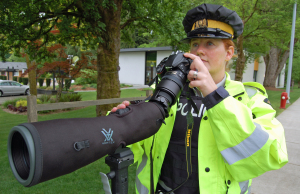Just like drinking and driving, there are deeper causes that need to be dealt with before we can justify long-range surveillance
By Lorraine SommerfeldOver the May long weekend, RCMP in British Columbia were setting up DSLR cameras with super-long lenses to snap drivers mucking with their phones and doing other distracted things. The resulting tickets will be backed up with photographic evidence, goes the thinking, because most of us suspend the belligerence when caught red handed.
With the ability to catch you in the act from over a kilometre away, I admit my initial thought was, “Finally, cops will start busting all those morons I see glued to their phones,” because I swear, every third car I pass has a driver texting. When people see a cop, they drop their phone. But this snoopy thing? Well, now we might be getting somewhere. Right?
Texting drivers are 23 times more likely to be involved in a collision. We know that, and yet, even as people wag a finger at drivers who use their cells, many are still doing it. Hands-free is legal, but not as safe as we pretend. Your eyes may be on the road, but your mind is not. Everywhere, fines and demerits are being raised and yet the problem persists, just like the fact that too many still drink and drive.
Decades of educating and legislating have seen the number of drunks behind the wheel fall, though even that seems to be just hammered down to a stubborn threshold; it seems we will never end a core group determined to drive after drinking, unless they are physically removed from the driver’s seat. Drunks get behind the wheel because drunks make that decision while they’re impaired; it’s why the campaigns all highlight making the decision before you’ve started imbibing, rather than after.
Seatbelt legislation is often used as a model of success for behavioural change. Most of us buckle up, and most of us know that seatbelts work in conjunction with those airbags. Not buckling up may be your idea of going rogue, but car manufacturers can only save you if you use the features as intended. A body repair shop worker I know tells me he can’t believe the condition of some of the cars that come into his shop after a major crash, and that the occupants were not severely injured. He says even a decade ago those same occupants would have been dead. Call me cynical, but I think a lot of those tumbling fatality statistics have far more to do with automotive safety advances than improved driver behaviour.
But cellphones are proving to be their own kind of hell on our roads. Cellphones and their connective counterparts – Twitter, texting, Facebook, email – can be addictive. They ping the same part of your brain that gets ramped up when you gamble or have sex, and give it a hit of dopamine. You’re not imagining that pull you feel when your phone rings, or a message lands. Your brain wants that rush. You’re supposed to enjoy things to feel that chemical release; it’s our hardwired reward system.
The problem arises when we combine these interactive exercises with driving – driving that needs to be not just our primary focus, but our only one. Car manufacturers have loaded a ton of distractions into today’s vehicles, and most have had to dial back what works as you’re rolling along; jamming away at a navigation system at speed is deadly, though so is trying to scroll through a bunch of touchscreens to turn down the heat. Manufacturers have a lot to answer for in their quest to let us entertain ourselves (sometimes to death), but handheld devices are on us, even when mated to the vehicle’s in-house systems.




